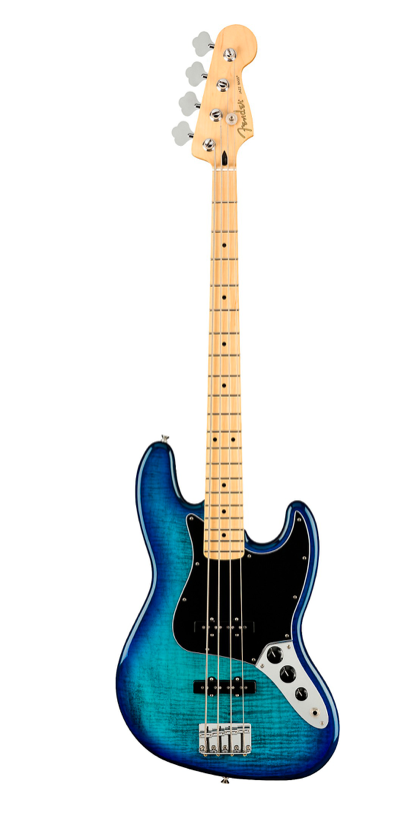The purpose of bass has widely been viewed as one that is quite rigid: to occupy the lower end of a composition, while being the glue that binds rhythm and melody together. Through such a lens, the bass serves a quintessential role in nearly every genre of music––yet is ironically an afterthought when compared to other instruments such as guitar, drums, and keys. Over the years, however, this hasn’t stopped the likes of prolific bassists such as Jaco Pastorius, Victor Wooten, Michael Manring and Billy Sheehan from demonstrating the bass guitar’s astonishing potential as a worthy solo instrument.
Another such bassist who has continued to break the mold is Mike Hall.
For over a decade, the New Jersey native has performed alongside some of the biggest artists in the world of pop and rock music. More recently; his avant-garde solo bass covers have accrued hundreds of thousands of total views across social media, being lauded as virtuosic reimaginings of songs that he has made his own.
In this article, we’ll be breaking down Hall’s creative approach, multifaceted playing technique, and how exactly he’s able to bring these arrangements to life, so that you too can follow suit in your own musical endeavors.
The process begins by figuring out a tuning that allows for the lowest note to be played on an open string, primarily for the purpose of being able to provide the bottom end of the arrangement in key without too much difficulty. In the case of Hall’s latest solo rendition of “Californication” by the Red Hot Chili Peppers, the piece begins in B minor, requiring the E string to be tuned all the way down to B. Additionally, the rest of the strings need to be tuned in a way that incorporates an ideal amount of tonal options to properly complement the general melody of the song. The resulting tuning that satisfies these conditions ends up being, from lowest to highest, B / B / E / A.
This allows for a general “order of operations” to be used consistently throughout the entirety of the piece: whenever the melody is performed, it is done so as a combination of harmonics and upper register notes––all of which are paired with a drone note that is typically played on either an open string, or a lower octave harmonic. This compositional perspective provides a full, ethereal, beautiful sound that is further augmented by use of piccolo bass strings, chorus reverb, and delay effects.
Now, on to the actual playing:
Mike Hall embellishes the arrangement with an array of techniques that help the ebb and flow of the song tremendously. One technique in particular that he incorporates quite often is muted percussion via ghost note triplets. This provides the piece with some much needed spacing between melody progressions, which directly combats instances of the song sounding stale or monotonous. These ghost notes also help accentuate specific harmonics and upper register notes all throughout the piece.
Another technique that’s utilized almost constantly is two handed tapping, which is used to not only perform the traditional bass and guitar parts simultaneously, but to also properly emulate certain segments of the melody. More traditional tapping methods are used as well in conjunction with an open string or lower harmonic drone note, which allows for unique variations of the melody to be played.
Slapping, popping, and flamenco strumming are also implemented, notably throughout the pre-chorus sections of the arrangement. Though these techniques are often seen in a variety of genres on their own, they can all be used together as tools to help manipulate the dynamics of any given song. For this piece in particular, Hall uses these techniques to aid in building crescendos, creating a stark contrast between the aggressive pre-chorus progressions and the calming chorus sections that are filled with higher octave harmonics.
The last aspect of Hall’s playing worth mentioning are two mid-song tuning adjustments, incorporated right before and after the bridge. The reasoning is to adjust for key changes that are consistent with the original version of the song, temporarily requiring a different set of harmonics and notes relative to the tuning on the other strings.
To get around this, Hall quickly tunes his low B string up to D, which allows him to proceed with the aforementioned creative methodology. At the conclusion of the bridge, he lets two higher octave harmonics ring out while quickly tuning his low D string back to B, which circumvents potential pacing issues that could arise from needing to abruptly stop to retune.
The bass can go as far as your imagination is willing; and whether you’re a seasoned professional or you just picked up an instrument for the first time, this breakdown should help get you started in being able to create arrangements of your own. Although there's plenty to take away from Mike Hall’s creativity, what may be most important of all is to understand that the purpose of any instrument is always up to you.
Mike Hall is a critically acclaimed bassist from New Jersey, sharing the stage with the likes of MGMT, Blondie, Blues Traveler, Third Eye Blind, Joan Jett & The Blackhearts, Sugar Ray, Lifehouse, Gin Blossoms, The Plain White T’s, 3 Doors Down, Smash Mouth, The Wallflowers, and Creedence Clearwater Revisited. His virtuoso playing has earned him features in The Aquarian Weekly, Bass Magazine, Music Mecca, and Bass Musician Magazine. Mike is also one of Skjold Design Guitars’ recently featured endorsees, and has released a debut solo EP titled The Next Step - which is available for streaming and download on all major platforms.
You can follow his journey, and subscribe to his content through the following:
Instagram: @mikehall.bass
YouTube: youtube.com/mikehallbass
Facebook: facebook.com/mikehallbass
Twitter: @mikehallbass















